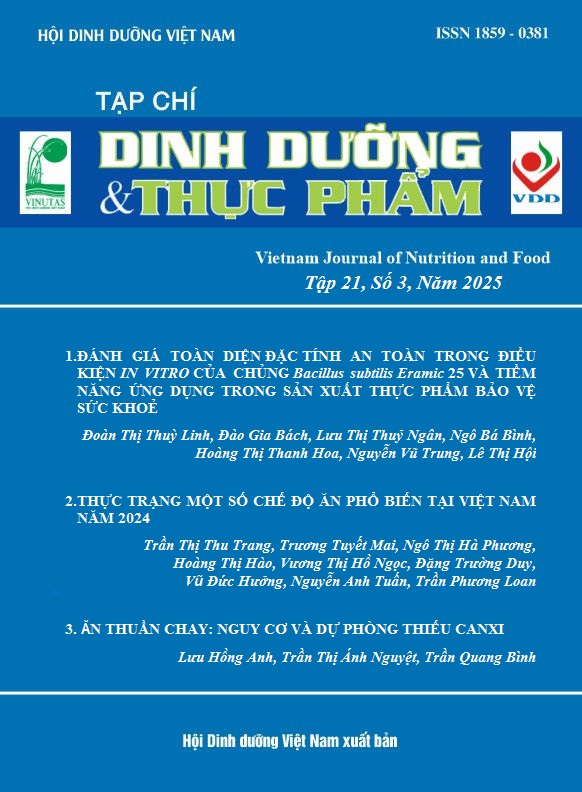THỰC TRẠNG MỘT SỐ CHẾ ĐỘ ĂN PHỔ BIẾN TẠI VIỆT NAM NĂM 2024
Nội dung chính của bài viết
Tóm tắt
Mục tiêu: Nghiên cứu được tiến hành nhằm khảo sát mức độ phổ biến của một số chế độ ăn theo vùng miền và dân tộc tại Việt Nam.
Phương pháp: Nghiên cứu cắt ngang được thực hiện qua bộ câu hỏi tự điền, xây dựng dựa trên tiêu chí xác định, thử nghiệm và điều chỉnh để đảm bảo tính chính xác, dễ hiểu trước khi tải lên Google Biểu mẫu. Liên kết biểu mẫu được gửi đến 62 cán bộ dinh dưỡng tại 62 Trung tâm Kiểm soát Bệnh tật tỉnh hoặc thành phố qua Zalo và email. Các cán bộ được hướng dẫn cụ thể về cách điền và hoàn thành biểu mẫu trong tối đa 30 ngày.
Kết quả: Chế độ ăn thông thường chiếm 100% ở các vùng, phổ biến nhất ở dân tộc Kinh (98,4%). Chế độ ăn theo tín ngưỡng trung bình 71%, cao nhất ở Đồng bằng sông Cửu Long (92,3%) và thấp nhất ở Đồng bằng Sông Hồng (54,5%), với dân tộc Kinh áp dụng nhiều nhất. Chế độ ăn lễ hội và chay lần lượt chiếm 75,8% và 82,3%, phổ biến ở các vùng đồng bằng và dân tộc Kinh (100%). Chế độ ăn cho người mắc bệnh là 91,9%, cao nhất ở dân tộc Kinh (98,2%), đặc biệt tại các vùng đồng bằng. Chế độ ăn giảm cân chiếm 82,3%, cao nhất ở Bắc Trung Bộ & duyên hải miền Trung (85,7%), phổ biến ở dân tộc Kinh. Chế độ ăn khác chiếm 24,2%, phân bố không đồng đều, chủ yếu ở dân tộc Kinh (100%).
Kết luận: Nghiên cứu cho thấy chế độ ăn thông thường là phổ biến nhất tại Việt Nam, đặc biệt trong cộng đồng dân tộc Kinh. Các chế độ ăn theo tín ngưỡng, lễ hội và cho người mắc bệnh cũng có tỷ lệ sử dụng cao, phản ánh sự đa dạng và đặc trưng văn hóa trong dinh dưỡng của các vùng miền và dân tộc khác nhau.
Từ khóa
Chế độ ăn, phổ biến, vùng miền, các dân tộc.
Chi tiết bài viết
Tài liệu tham khảo
2. Clark M., Macdiarmid J., Jones A.D. và cộng sự. The Role of Healthy Diets in Environmentally Sustainable
Food Systems. Food Nutr Bull. 2020. 41(2_suppl), 31S-58S.
3. Fumiaki Imamura, Renata Micha, Shahab Khatibzadeh, et al. Global Burden of Diseases Nutrition and Chronic Diseases Expert Group (NutriCoDE). Dietary quality among men and women in 187 countries in 1990 and 2010: a systematic assessment. Lancet Glob Health. 2015 Mar;3(3):e132-42.
4. A Naska, D Fouskakis, E Oikonomou, et al. DAFNE participants. Dietary patterns and their socio-demographic determinants in 10 European countries: data from the DAFNE databank. Eur J Clin Nutr. 2006 Feb;60(2):181-90.
5. Trần Thị Ánh Hồng. Văn hoá ẩm thực của người H’ mông Vùng Tây Bắc Việt Nam. Khoá luận tốt nghiệp đại học, ngành Việt nam học. 2014.
6. Trần Quốc Vượng, Nguyễn Thị Bảy. Văn hoá ẩm thực Việt Nam nhìn từ lý luận và thực tiễn, Nxb Từ điển Bách Khoa và Viện Văn hoá, Hà Nội. 2010.
7. Đào Hùng. Câu chuyện ẩm thực dưới góc nhìn lịch sử, Nxb Phụ Nữ, Hà Nội. 2012.
Các bài báo tương tự
- Bùi Thị Khánh Thuận, Bùi Thị Thuý Nga, Dương Tuấn Linh, Trần Quang Bình, TỐI ƯU QUY TRÌNH PHÂN TÍCH ĐA HÌNH ĐƠN NUCLEOTIDE NPC1L1 rs2072183 BẰNG PHƯƠNG PHÁP ĐA HÌNH CHIỀU DÀI ĐOẠN GIỚI HẠN , Tạp chí Dinh dưỡng và Thực phẩm: Tập 20 Số 6 (2024): HỘI NGHỊ KHOA HỌC VIỆN DINH DƯỠNG NĂM 2024
Ông/Bà cũng có thể bắt đầu một tìm kiếm tương tự nâng cao cho bài báo này.


